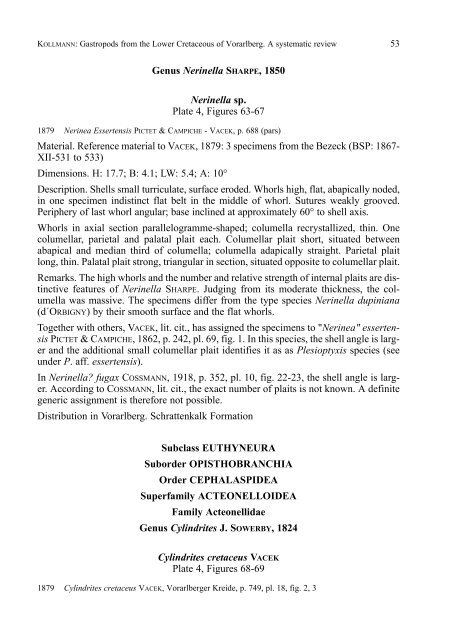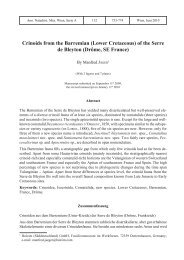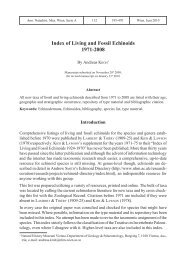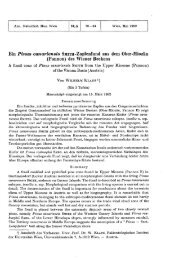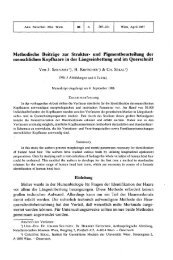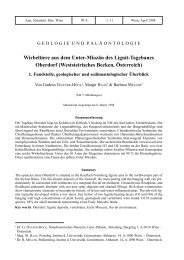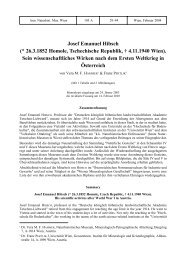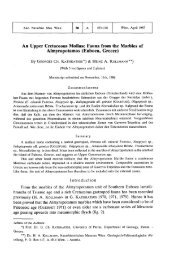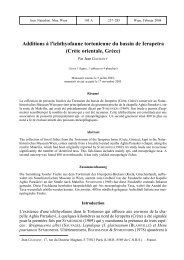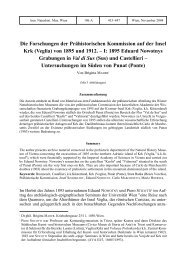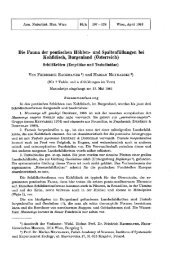Gastropods from the Lower Cretaceous of Vorarlberg, Austria. A ...
Gastropods from the Lower Cretaceous of Vorarlberg, Austria. A ...
Gastropods from the Lower Cretaceous of Vorarlberg, Austria. A ...
Create successful ePaper yourself
Turn your PDF publications into a flip-book with our unique Google optimized e-Paper software.
KOLLMANN: <strong>Gastropods</strong> <strong>from</strong> <strong>the</strong> <strong>Lower</strong> <strong>Cretaceous</strong> <strong>of</strong> <strong>Vorarlberg</strong>. A systematic review 53<br />
Genus Nerinella SHARPE, 1850<br />
Nerinella sp.<br />
Plate 4, Figures 63-67<br />
1879 Nerinea Essertensis PICTET & CAMPICHE - VACEK, p. 688 (pars)<br />
Material. Reference material to VACEK, 1879: 3 specimens <strong>from</strong> <strong>the</strong> Bezeck (BSP: 1867-<br />
XII-531 to 533)<br />
Dimensions. H: 17.7; B: 4.1; LW: 5.4; A: 10°<br />
Description. Shells small turriculate, surface eroded. Whorls high, flat, abapically noded,<br />
in one specimen indistinct flat belt in <strong>the</strong> middle <strong>of</strong> whorl. Sutures weakly grooved.<br />
Periphery <strong>of</strong> last whorl angular; base inclined at approximately 60° to shell axis.<br />
Whorls in axial section parallelogramme-shaped; columella recrystallized, thin. One<br />
columellar, parietal and palatal plait each. Columellar plait short, situated between<br />
abapical and median third <strong>of</strong> columella; columella adapically straight. Parietal plait<br />
long, thin. Palatal plait strong, triangular in section, situated opposite to columellar plait.<br />
Remarks. The high whorls and <strong>the</strong> number and relative strength <strong>of</strong> internal plaits are distinctive<br />
features <strong>of</strong> Nerinella SHARPE. Judging <strong>from</strong> its moderate thickness, <strong>the</strong> columella<br />
was massive. The specimens differ <strong>from</strong> <strong>the</strong> type species Nerinella dupiniana<br />
(d´ORBIGNY) by <strong>the</strong>ir smooth surface and <strong>the</strong> flat whorls.<br />
Toge<strong>the</strong>r with o<strong>the</strong>rs, VACEK, lit. cit., has assigned <strong>the</strong> specimens to "Nerinea" essertensis<br />
PICTET & CAMPICHE, 1862, p. 242, pl. 69, fig. 1. In this species, <strong>the</strong> shell angle is larger<br />
and <strong>the</strong> additional small columellar plait identifies it as as Plesioptyxis species (see<br />
under P. aff. essertensis).<br />
In Nerinella? fugax COSSMANN, 1918, p. 352, pl. 10, fig. 22-23, <strong>the</strong> shell angle is larger.<br />
According to COSSMANN, lit. cit., <strong>the</strong> exact number <strong>of</strong> plaits is not known. A definite<br />
generic assignment is <strong>the</strong>refore not possible.<br />
Distribution in <strong>Vorarlberg</strong>. Schrattenkalk Formation<br />
Subclass EUTHYNEURA<br />
Suborder OPISTHOBRANCHIA<br />
Order CEPHALASPIDEA<br />
Superfamily ACTEONELLOIDEA<br />
Family Acteonellidae<br />
Genus Cylindrites J. SOWERBY, 1824<br />
Cylindrites cretaceus VACEK<br />
Plate 4, Figures 68-69<br />
1879 Cylindrites cretaceus VACEK, <strong>Vorarlberg</strong>er Kreide, p. 749, pl. 18, fig. 2, 3


